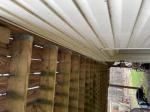Installing Railing Posts With Post Anchor
Attaching the anchor to cumaru and exotic hardwood posts like Ipe is identical in principle to softwood but requires one additional step.
Warning: Working with cumaru, ipe or any hardwood can be dangerous. Do not try this if you are not skilled with woodworking tools.
However the anchor to post connection with exotic hardwoods is the strongest you can get using the Titan Post Anchor. Here is how its done...
Step 1: Cut Post

Cut the post to length as you normally would.
But since Ipe and Cumaru are so hard you absolutely should be using a good Miter saw with a high quality carbide bit designed for cross cutting.
Make sure the are no knots near the end of the post. Fortunately with these woods you very rarely see any knots as the grain is so tight and dense.
Step 2: Mark Center

Mark the center of the post as normal.
Use a sharp soft leaded pencil and draw diagonals from corner to corner. Use a straight edge.
If the the radius of the corner is significant, which it usually isn't with these woods, mark the middle of the corner with the pencil and use that as your reference point for the straight edge.
Step 3: Pre-Drill Center

Drill a pilot hole
Use a sharp drill bit that is slightly smaller than the drill bit in your hole saw. Go slow and make sure you stay as close to perfectly perpendicular (90 degrees) as possible.
This drill has a water level with a bubble built into the handle to make it easy. Drill down at the center point about 2" deep.
Step 4: Hole Saw First Plunge

Use a hole saw for the first pass.
Take a sharp hole saw because Ipe and Cumaru can make your blades dull pretty quickly.
Keep the blade as close to perfectly perpendicular as possible and drill straight down using the pilot hole as a guide. You know you are perfectly straight if all sides of the hole saw start cutting the wood at the same time.
Step 5: Remove Core With Forstner Bit

Use a 1.25" Forstner bit to remove some wood from inside the hole saw cut.
Warning: Secure the post somehow or even better use a drill press.
To prevent kick back, ensure the drill is always straight up and down, not tilted on an angle and do not push down too hard or too fast.
Let the tool do the work.
Plunge to a depth of 1-1/2" maximum. The instructions with each post anchor show this in very nice illustrations.
Step 6: Hole Saw Second Plunge

Use a hole saw for a second pass.
Now use the hole saw and drill down as far as you can go. Think of it this way...
The Forstner bit has now cleared out wood down to the 1-1/2" depth and the hole saw is 1-7/8" long so now the hole saw can cut to a total depth of 3-3/8". That is just 1/8" less than the 3-1/2" length of the tube.
You will only need the tube to bite a little bit into the wood and even this will be hard.
If the weld along the base of the tube is large, you may have to use a router or file and chamfer the edge of the hole cut so the anchor will seat fully on the end of the post.
Step 7: Hammer Anchor Down

Drive the tube into the hole cut with a 3 lbs sledge.
You will only have about 1/4" or 1/8" at most of uncut wood to hammer the tube into. That is still a lot of hammering given how hard this wood is. If one side is slightly high because your hole wasn't perfectly straight, tap that side.
But don't worry too much because the lag bolts get a lot of grip in hardwood and can pull that down flush.
Step 8: Pre-Drill Screw Holes

Drill pilot holes for the bolts.
You must drill pilot holes for the lags. Use a bit that is 1/32" smaller diameter than the outside threads of the screw.
It may seem like that is not much but in hardwood you will find it very hard to screw anything into it.
Step 9: Impact Wrench Or Hand Ratchet

Ratchet the bolts down into the post.
Or use an impact wrench. Ipe and Cumaru are really tough.
Good work. You're done attaching the anchor to cumaru.
A lot harder than softwoods like pine but worth it.
Cumaru Post & The Titan Post Anchor

You will be rewarded with a very sturdy connection and your posts will now last literally a life time, staying high and dry from surface moisture.
Also, the strength of the connection is stronger than with softwood given the density of Specific Gravity of Ipe and Cumaru which is around .90. Cedar is somewhere around .40. So the breaking point is much higher with these species.
And it looks super! Clean and beautiful to look at. But functionally a high performer as well. Ipe and Cumaru are great woods for outdoor railings but require more care and skill to work with.
Home > Titan Post Anchor Forum > Attaching Anchor To Cumaru



























